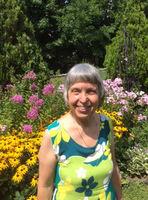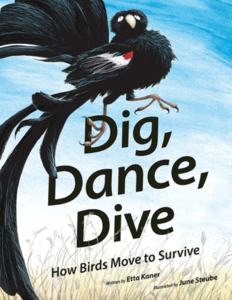Beyond Flight: Etta Kaner Helps Kids Love Birds with Her Fascinating, Funny, Strange Book of Bird Habits
Anyone who is or knows a bird lover, knows that bird watching can be its own free, endless source of entertainment. In Etta Kaner's Dig, Dance, Dive: How Birds Move to Survive (Owlkids, illustrated by June Steube), young readers get a chance to join the worldwide club of folks who find birds fascinating, by discovering unexpected facts about how birds move. From flight to digging to dances, birds both flying and ground-bound are celebrated with acclaimed educator and award-winning author Kaner's signature humour. From tobogganing penguins to head-spinning owls, Kaner's passion for her feathered friends, in all their strange, funny, fascinating glory, will help grab kids' attention.
We spoke with Etta about Dig, Dance, Dive and her process for creating absorbing nonfiction books for young readers. She told us about her favourite (and very cute) new bird discovery she made in the process of writing the book, the enviable behind the scenes tour she got as part of her research, and why she is passionate about making sure kids have great nonfiction options.
Open Book:
Tell us about your new book and how it came to be. What made you passionate about the subject matter you're exploring?
Etta Kaner:
Dig, Dance, Dive: How Birds Move to Survive is about the various ways birds move to help them survive. When you think of birds, the first action that comes to mind is flight. Then you might think of hopping and swimming. But there are so many other movements that birds do and so many amazing birds that do them. What excited me was learning about birds that were totally new to me like the kakapo. Every time I look at this bird, I laugh. Its face is so adorable. And its movements are so unusual. I just love discovering new and interesting information.
OB:
What was your research process like for this book? Did you encounter anything unexpected while you were researching?
EK:
After doing some initial brainstorming, I was lucky enough to go on a behind the scenes tour of the ornithology archives at the Royal Ontario Museum in Toronto. I got to see and hear about many kinds of birds including a great many birds, both existing and extinct, that don’t fly! I was also very fortunate to interview the curator of birds at the ROM. He checked my bird selections and made suggestions about other possibilities. After that, I did my research online, using trusted sources like the Smithsonian or the Cornell Lab of Ornithology as well as speaking with ornithologists who were knowledgeable about specific birds.
OB:
What do you love about writing nonfiction? What are some of the strengths of the genre, in your opinion?
EK:
Writing nonfiction allows me to make discoveries about surprising and fascinating elements of nature, be it plants or animals. Especially during our environmental crisis, it’s important to get kids excited about and interested in nature. They need to have an emotional investment in nature in order to be the future stewards of our planet. Providing kids with well written nonfiction books is one way to accomplish this.
OB:
What does the term creative nonfiction mean to you?
EK:
In my mind, creative nonfiction goes beyond the straight-forward presentation of factual information. The facts are woven into a fictional situation. I did this with my book And the Winner Is … Amazing Animal Athletes. The animals presented in the book are competing in various athletic events. The book has two narrators/sportscasters who share some of the facts while speech bubbles and mini sidebars impart the rest.
Your CanLit News
Subscribe to Open Book’s newsletter to get local book events, literary content, writing tips, and more in your inbox
OB:
Do you remember the first moment you began to consider writing this book? Was there an inciting incident that kicked off the process for you?
EK:
Actually, I do (which is not always the case with my books). My husband and I were chatting with a friend who is an ornithologist. I was asking him about a bird that I had seen in our garden but was unable to identify. For some reason, he said “Birds don’t just fly, you know.” That sentence got me thinking about other bird movements. As a matter of fact, the original title of this book was Birds Don’t Just Fly.
_________________________________________________
Etta Kaner writes for both children and educators. Many of her books have won awards including the Silver Birch Award, the Henry Bergh Award, the Animal Behaviour Society Award, the Science Writers and Communicators of Canada Award, the Scientific American Young Readers Book Award, and the Science in Society Book Award. Etta lives in Toronto, Ontario.





